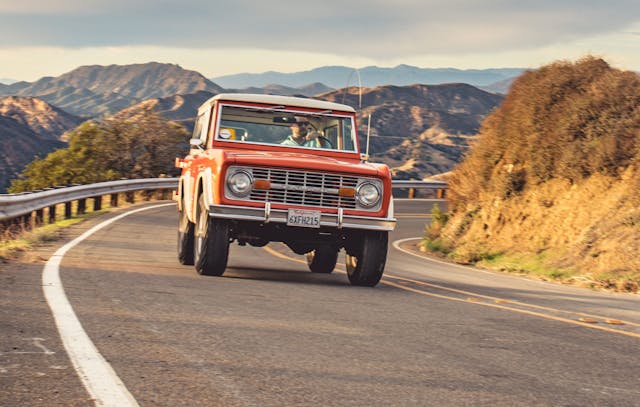Your handy 1966–77 Ford Bronco buyer’s guide
There’s a lot of attention surrounding the Ford Bronco now that—finally—after a 25 year hiatus, a new Bronco is set to roll into garages all over America. While the 2022 Ford Bronco is obviously a completely different beast than the first-generation Broncos from 1966 to 1977, its design avoided replicating the style of the three other generations of the full-size Bronco. And the ways the new Bronco tipped its hat to the original model are clear, especially when you dig into the year-to-year changes of the original.
Model Overview
1966
There’s no doubt that Ford product manager Donald Frey and Lee Iacocca wanted a piece of the action that Jeep and International Harvester were enjoying with the CJ-5 and Scout 80, which together sold over 30,000 units a year combined. Not to mention Ford was no stranger to the concept, as they built over 270,000 Jeeps during WWII, and in 1951, designed the M-151 or “MUTT,”which became the successor to Willys’ M38A and M38A1. Ford was hungry for a piece of the sport-utility pie.
Prototype Broncos arrived in January of 1966, overseen by Ford engineer Paul Axelrad. Their aim was to succeed in the areas where the CJ-5 and the Scout 80 fell short (both had short wheelbases but neither were particularly maneuverable). Neither the Jeep nor the Scout had a six-cylinder engine (when the first Bronco prototype was tested) and they both had a narrow track, leading to rollovers on sidehills.
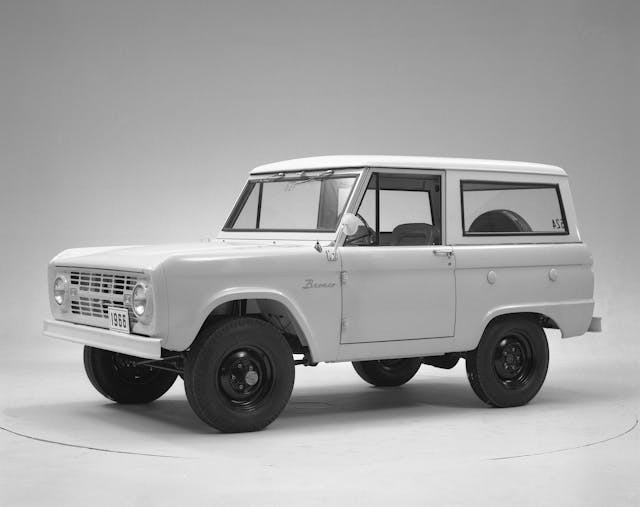
While the Bronco may seem primitive compared to modern vehicles, the production version that launched on August 11, 1966 solved every one of the competition’s shortcomings. The 92-inch wheelbase is shorter than that of both competitors, enough to achieve a 33.6-foot turning radius—three feet smaller than the CJ-5 and a staggering 9.5 feet smaller than the Scout 80. The Bronco also used a much more sophisticated “Mono-Beam” front suspension with coil springs and radius rods up front, offering a smoother ride and allowing the wheels to turn more effectively. The setup includes a one-inch diameter track bar for lateral stability. And at 57.4 inches, the Bronco had a track four inches wider than the CJ, plus better brakes, with 11-inch drums up front and 10 inch drums in the rear.
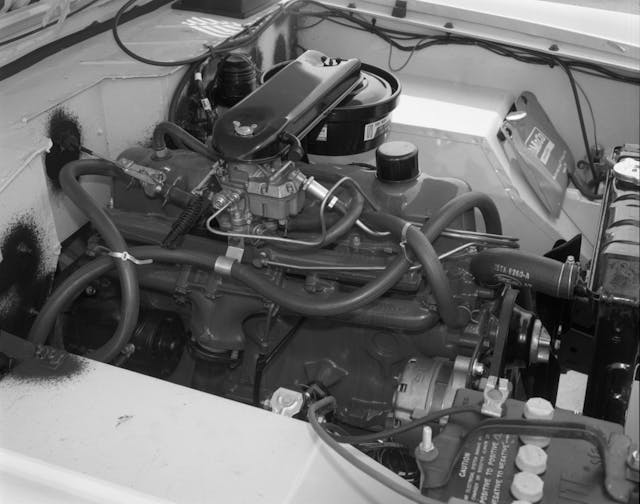
The only engine available in the first Bronco was the 102-hp 170-cu-in six cylinder, a dramatic upgrade over the Jeep’s four-cylinder engine. (For the 1966 model year the CJ got an optional Dauntless 225 V-6.) In the Bronco brochure from 1966, the 200-hp 289-cu-in V-8 was promised for “mid-March” of 1967.
The transmission was better, too. The Bronco’s three-speed manual was the first fully synchronized transmission in any 4×4 vehicle available in the United States. The Bronco also used a Dana 20 transfer case with a single T-bar shift lever with a positive lock knob, similar to the shifter on a Mustang, versus the Jeep’s Dana 18 with twin sticks.
Mechanicals aside, the Bronco was well appointed inside compared to the CJ or the Scout. The package included rugged features like a fold-down windshield and vacuum operated wipers, but the Bronco also had doors with roll-up windows and a frame for the glass. Remember, the CJ-5 lacked doors unless you went to aftermarket suppliers like Koenig, Meyer, or Sears. The Bronco sported standard items like turn signals (an add-on for Jeeps), a padded dash, seat belts, and windshield washers.

The 1966 Bronco was also available in three separate body styles, the first being a Bronco Roadster with no roof, and a swooping, dogleg-style door opening similar to the CJ-5’s. A vinyl top was available from the massive accessory catalog. The Bronco Sports Utility pickup had a full square door opening with a half-cab roof, with a bench seat inside. The cargo area on the Sports Utility was separated by a metal bulkhead, providing a small bed separate from the passenger compartment. The Bronco Wagon had the same full doors, but with a roof that enclosed both cargo and passenger areas, a standard bench seat, optional bucket seats and an optional rear bench seat.
Another Bronco advantage was the full-width tailgate. The tailgate on the Jeep was only the width between the wheel wells, and was held up with chains. The Bronco tailgate had a center latch for one-handed operation, and had a full, 56-inch wide tailgate opening. In this first year the Bronco was available in 10 colors and Ford sold 18,200 units. Not a huge success, but the Bronco was definitely competitive against the CJ-5.
1967
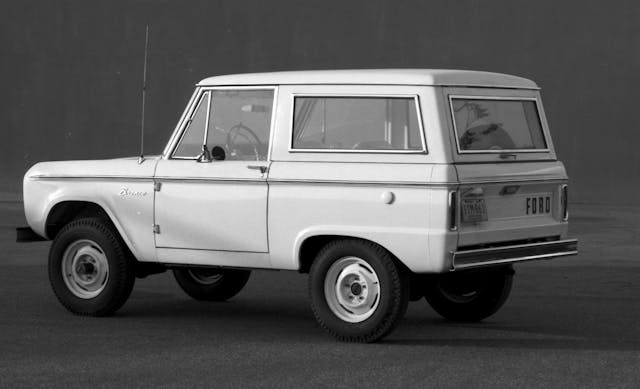
After the big launch in 1966, the changes for 1967 were limited. Padded sun visors moved from the option catalog to the standard features list. The T-bar shifter lost the positive lock knob. Like most vehicles that were anticipating the rollout of new Federal Motor Vehicle Safety Standards, Ford opted for a dual-reservoir master cylinder for the brakes, and mandated backup lights as a standard safety feature. The brakes also became self-adjusting in 1967.
The Bronco also had a few options added to its already long list in 1967. An 11.5-gallon auxiliary fuel tank was added, with the filler neck on the same side as the main tank. Optional packages for all three body styles offered new dual armrests, chrome bumpers, chrome grille, and chrome light bezels.
Color changes resulted in the total number of colors increasing to 13. Ford built 16,100 Broncos for the 1967 model year.
1968
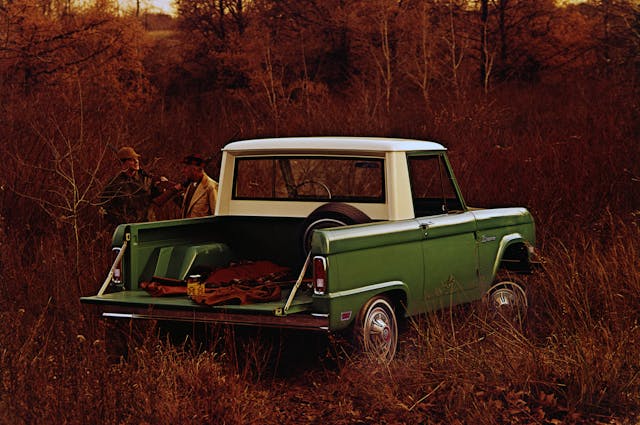
A handful of mechanical changes marked the 1968 model year. A new replaceable, dry air filter replaced the oil-bath unit, and free-wheeling lockout hubs became standard. The disappearing button on the transfer case T-handle made a triumphant reappearance for ’68.
There were a few design revisions, too. New side marker lights were incorporated on the lower front fender, with amber lenses. The interior door handles were revised from a pull-up style to a recessed flipper, for both aesthetic and safety reasons. The option list grew by one item: a new swing-away spare tire carrier, which freed up a significant amount of space in the cargo area. The number of available color choices stayed at 13, and Ford pumped out 15,700 Broncos this year.
1969
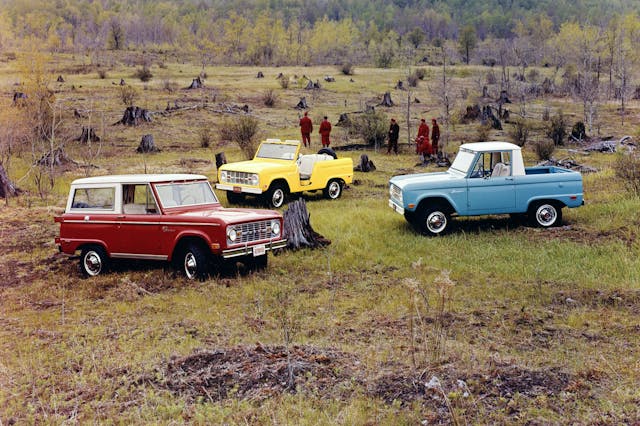
There were two notable changes for 1969, and the first was in the engine bay. Gone was the 289 V-8, and in its place came the 302 V-8, with a modest jump in horsepower (to 205 hp) but a significant jump in torque from 282 to 300 lb-ft. Broncos equipped with the 302 got a “302 V-8” emblem on the front fenders.
The second major revision was the elimination of the Roadster body style. It was a slow seller from the get-go, and despite its cheap base price, many more Bronco customers opted for the full cab. A reinforced body structure helped to seal out both water and dust from the passenger cabin. The windshield wipers switched from vacuum operation to a two-speed electric motor after mid-1968 production. Unfortunately, the wiper motor’s location meant that the latches for the fold-down windscreen were now eliminated.
The 1969 brochure shows red rear marker lights on the rear fender and that color availability jumped to 15. Ford sold 19,200 Broncos, the model’s biggest sales year to that point.
1970
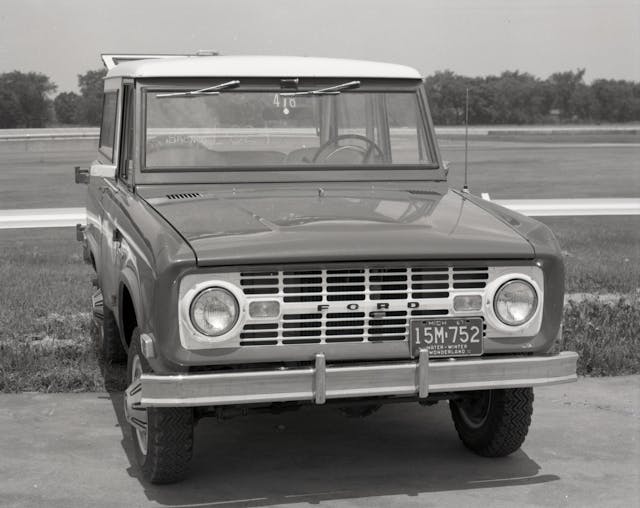
Since the beginning of production, Ford offered a Sport package, which it now transformed into a distinct trim level. The Sport trim levels were available on both the Bronco wagon and the Pickup.
Both the front and rear side marker lamps moved north on their respective fenders, to about the belt line, for better visibility. Fuel capacity for both tanks decreased in 1970. The front auxiliary tank dropped to 10.3 gallons, while the main tank was reduced to 12.7. Available color choices rose to 17, and Ford sold 18,500 Broncos in 1970.
1971
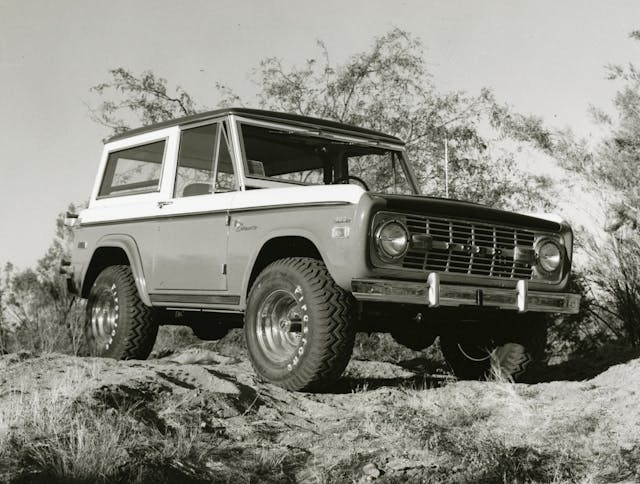
In ’71 things got a bit beefier. From ’66 to ’70, Ford used the a Dana 30 up front and a Ford 9-inch in the rear. Beginning in ’71, you got a Dana 44 up front along with the 9-incher out back. Color choices bloomed to 18, and Ford sold 18,700 Broncos.
Bill Stroppe had been campaigning the Bronco and beating the pants off the competition in the Baja 500 and 1000. In celebration, for the 1971 model year Ford participated in production of the Stroppe Baja Bronco. These special editions—only about 650 sold from 1971 to 1974—were sold by Stroppe as new, and featured a Poppy Red and Wimbledon White paint scheme, along with a hardtop with a Bright Blue Metallic roof. Each one had a Satin Black hood to reduce glare. The trucks also received a rear seat, heavy-duty cooling, the swing-away tire carrier, a heavy duty suspension, a unique exhaust, and the extra fuel tank as standard features.
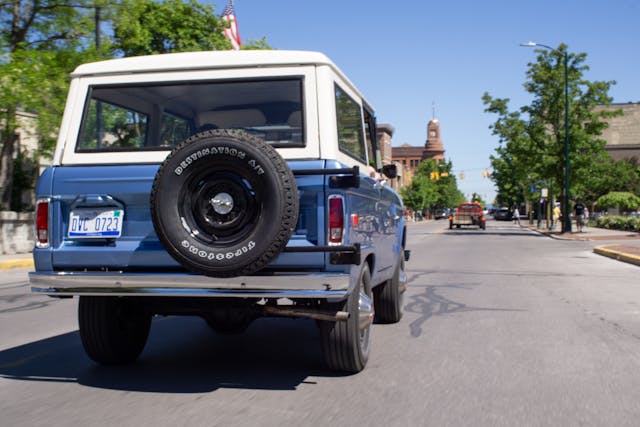
But that was just the bits added at Ford’s assembly line; these special editions were shipped to Stroppe’s facility where final assembly and sales occurred. These are the ONLY early Broncos you’ll find that have trimmed fenders and are actually worth more than a Bronco wagon with uncut fenders. Stroppe’s added riveted fender flares in order to clear the 15 x 8.5 painted steel wheels with Gates off-road tires. Chrome steel wheels were an option. Later Bajas would have Ansen-style slot mags.
Both power steering and an automatic transmission were part of the Baja package, neither of which were available on the standard Bronco. That required a specially cast tail shaft housing in order to buddy up with the transfer case. Bronco Bajas had a GM Saginaw steering box with a custom bracket designed at Stroppe’s facility.
Bronco Bajas also received a unique steering wheel, a roll bar, a trailer hitch and dual shocks at all four corners, along with a unique spare tire cover.
1972
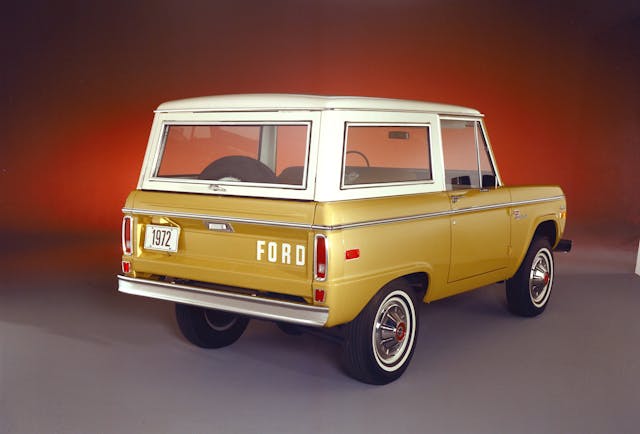
The only mechanical change for ’72 was the shift pattern of the transfer case. Aside from the disappearing and reappearing lockout knob, the pattern had been inline since day one. For ’72, it changed to a J-pattern, which was now standard with a 2.34:1 low range.
The option list got a new Ranger package, which included die-cast FORD letters for the grille, the swing-away tire carrier, a RANGER-branded tire cover, color-matched carpeting and interior panels, cloth high-back bucket seats, wood grain vinyl appliqué on the door panels, racing stripes, a chrome bumper and chrome bezels for the dash.
Additionally, V-8 models lost the “302” emblem, and the spare fuel tank was reduced to a less-helpful 7.5 gallons. Colors were reduced to 17 for 1972 and 18,300 new Broncos found homes.
1973

This was a banner year in terms of driving convenience for the ’72 model year. The 170-cu-in inline-six was phased out and replaced with the more powerful 200-cu-in six. With the exception of the Stroppe Baja Bronco, it would be the first time that a C4 automatic transmission and power steering would be on the option list for the Bronco.
On the demerit side of the ledger, the slow-selling pickup model was discontinued for 1973. But all of these changes meant a sales spike for the Bronco, which was now going on its eighth year of production. The landscape was shifting however, as Chevrolet’s Blazer pointed toward a new direction in two-door SUV design. Still, Ford built 26,300 Broncos, more than it had built since 1969, and its best-selling year to this point, and 17 colors rounded out the palette.
1974
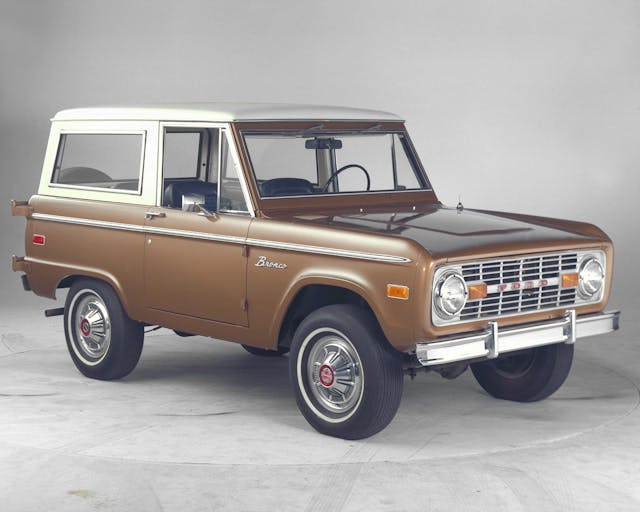
After the big revisions in 1973, the 1974 model year changes were mostly cosmetic. On Broncos with automatic transmissions, the gear indicator was now lighted, and all Broncos with a roof received a dome light in place of a map light. Up until 1974, the order guide included a front limited-slip differential, which was discontinued this year, along with the 4.11 gear ratio. 18 colors were available, and Ford enjoyed another strong year for sales with 21,400 built.
1975
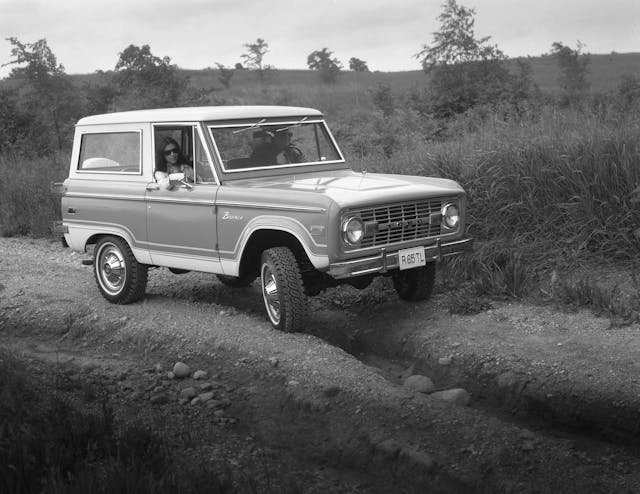
To modify a familiar Ford phrase, you could get any engine you wanted in the Bronco in 1975, as long as it was a V-8. The six cylinder was gone, and in its place was the 302 V-8 with a two-barrel carb. That engine was equipped with a catalytic converter and required unleaded fuel. An engine block heater was added to the option list for Bronco owners in colder climates.
18 colors were available, and after two of the Bronco’s strongest sales years to date, production plummeted to 13,200 units.
1976
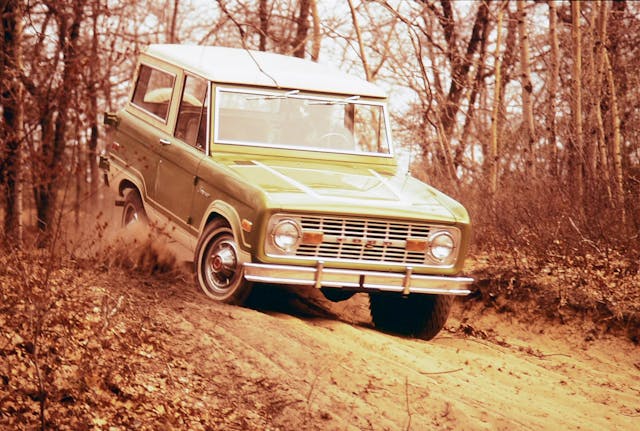
Milking the last out of the Bronco, Ford made a lot of changes in this year of America’s bicentennial year. Especially with the brakes—deletion of front drum brakes in favor of discs, 11×2.25 inch drums in the rear, and a variable ratio parking brake. Bronco’s also received a new power steering box that quickened the steering from 5.3 turns to 3.8 turns lock-to-lock, and the 302 received standard Dura-Spark electronic ignition.
The option list grew to include a stabilizer bar, heavy-duty shocks, and a Special Décor Group that included a flat black grille, tape stripes, and bright windshield molding. 14,500 Broncos were built for 1976, available in 16 different colors.
1977
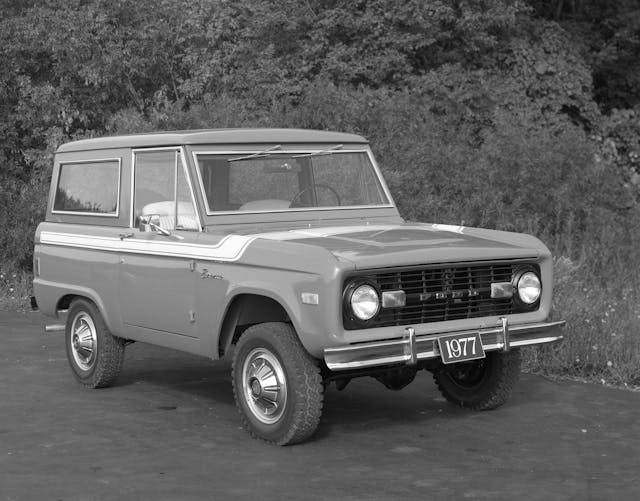
The final year for the first-generation Bronco included a number of significant revisions. The fuel caps were removed in favor of fuel filler doors. Side marker lights were now vertical, and the rear differential housing was revised for extra strength. The standard features list lost two items: the passenger seat was now optional again, which it hadn’t been for years. The padded dash also became an option. Power brakes were added to the option list for the very first time, while the auxiliary fuel tank grew a half gallon (to eight gallons) and was now made of plastic.
The last year for production also served as the most popular. 30,700 Broncos in 18 colors were produced in 1977, beating the best year to this point by more than 4000 units.
Before you buy
There’s nothing mechanical that’s all too scary about a Ford Bronco. Both the 170- and 200-cu-in sixes are solid, largely bulletproof, and relatively cheap to repair. The 289 and 302 V-8s are basic, common engines easily rebuilt by anyone with rudimentary skills. Aside from the linkage for the column-shifted three-speed manual, the three-speed Toploader is about as basic as it gets. Rebuilt examples are readily available for $600, and a rebuild on a matching-numbers unit should be relatively cheap.
The transfer case is a Dana 20, one of the strongest, lightest and most capable T-cases available from the era, which found its way into everything from this light-duty rig to the Jeep J4000 one-tons. The only thing of note is that the front mounting pattern on the case for Broncos is specific, and not compatible with other Dana 20s. They’re available, though, and for not a lot of dough. Differentials are either Dana 30s or Dana 44s up front and a Ford 9-inch at the rear—all plentiful.
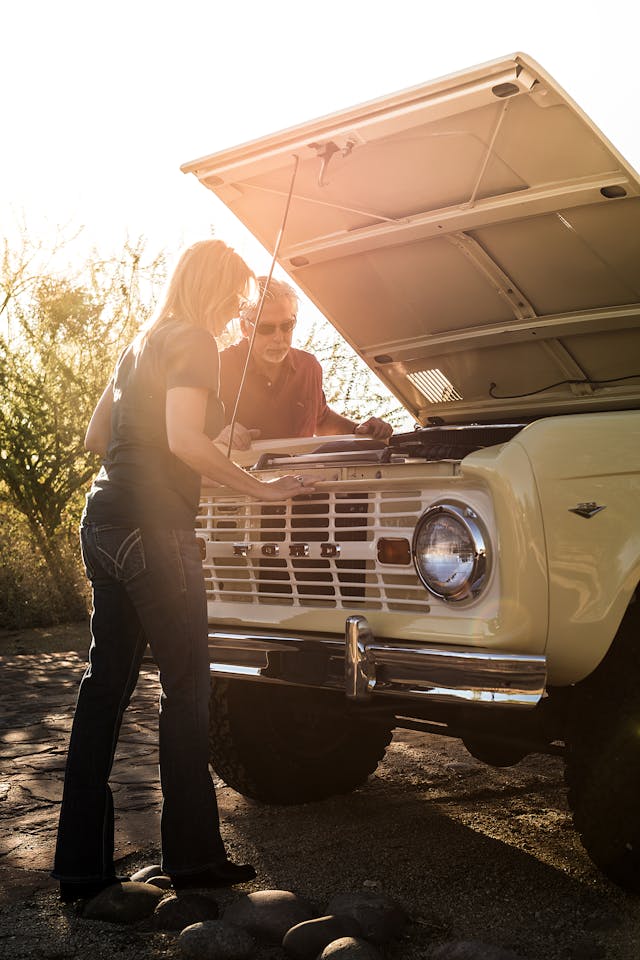
That’s the good news. The bad news is that rust destroyed these trucks almost from the moment they arrived on dealer lots. Not only was sheet metal preparation not to today’s standards, their construction underneath seems to be actively foster corrosion. There are shelves, pockets, nooks and crannies where dirt and salt can collect and stay wet, rotting frames, floors, and rocker panels with vigor.
Owners were not always kind, either. These compact SUVs were used up when they were new, and then again by their next owners when they were often built into trail rigs and beach wagons. They were generally destroyed in the process. Ford built hundreds of thousands of Broncos between 1966 and 1977, and the vast majority were trashed. Fenders were cut to add larger wheels and tires, homemade lift kits were installed, and so on.
Luckily, there’s a strong community of people who are dedicated to their preservation. Outfits like Bronco Graveyard offer expert advice, tons of new parts and loads of reclaimed parts to keep these trucks on the road.
1966 to 1977 Bronco Values
The Hagerty Valuation team notes that Bronco values started climbing around 2011, but really hit their stride between 2017 and 2019. (For the latest valuation data, please click here.) For example, from the end of 2016 to the end of 2019, the median #2 (Excellent) value for an early Bronco shot up 84 percent. Roadster models doubled in value, and that story was similar for the V-8-powered wagon. Median #2 value for a 1966–77 Bronco is $53,650 compared to $39,500 for a 1969–72 Chevy Blazer and $28,500 for a 1972–80 International Scout II.

Bottom of the barrel #4 (Fair) condition Broncos are still ranging anywhere from $15,000 to $22,000 depending on the engine. There seems to be little difference in price between automatics and manuals, but the latest early Broncos equipped with power steering seem to be the most expensive.
In the last year, not a single 1966–77 Bronco sold on Bring A Trailer for less than $21,000. A no reserve 1971 Bronco Pickup with rough paint, a 170-cu-in six, a three-speed and torn seats sold in March of 2021 for $21K. While warnings about the values of uncut fenders and original engines are plentiful, the market does not support that speculation: Generally, customized or restomodded first generation Broncos sell extremely well at auctions like Barrett-Jackson. Among the classic Broncos at Scottsdale this year, for example, 60 percent were modified in some way and the average price was over $111,000.
The median quoted value for an early Bronco is $29,600. The quoted value is up 74 percent over the last five years and the number of quotes Hagerty processed over that same timeframe is up 79 percent.
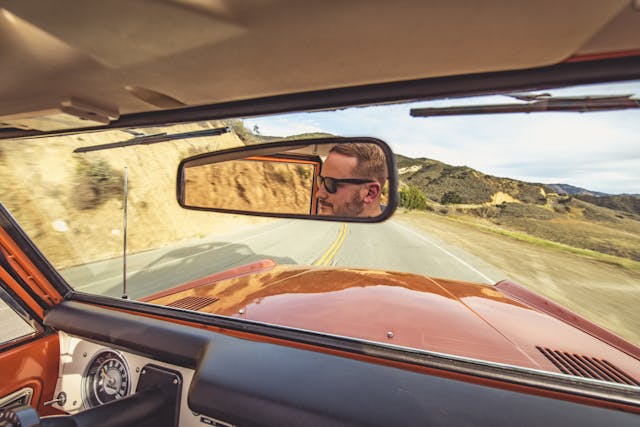
The demographics for first-gen Bronco owners who asked for a Hagerty insurance quote will be a bit surprising to some readers. You might expect that baby boomers who saw these vehicles arrive a couple of years after the Mustang would be the dominant Bronco demographic, but they represent about 28 percent of the audience for these trucks, while making up 39 percent of the hobby overall. Fifty percent of the quotes Hagerty processed for early Broncos came from Gen X, despite making up a slightly smaller percentage of the hobby overall than boomers. In general, however, vintage trucks and SUVs are disproportionately more popular with Gen Xers than any other demographic group. The balance of quotes for early Broncos came from millennials at 20 percent, versus 18 percent of the hobby overall; pre-boomers, who requested 3 percent of the quotes, make up 7 percent of the hobby, and Gen-Zers, who requested 1 percent of the quotes, make up 5 percent of the total collector car market.
Considering the vibrant, reinvigorated interest in the first-generation Bronco from all across the collector car community, if you wanted to get in for a truly affordable price, the time to get one was probably 10 years ago. The desire for two-door SUVs has gone bananas across the board, and first-gen Broncos are perceived as special in comparison to the more common CJ-5, and they have a much larger fan base than the International Harvester Scout. Prices don’t seem to be going anywhere for the moment, so the old adage still rings true: Find the best-condition Bronco you can find in your price range and enjoy the ride.
